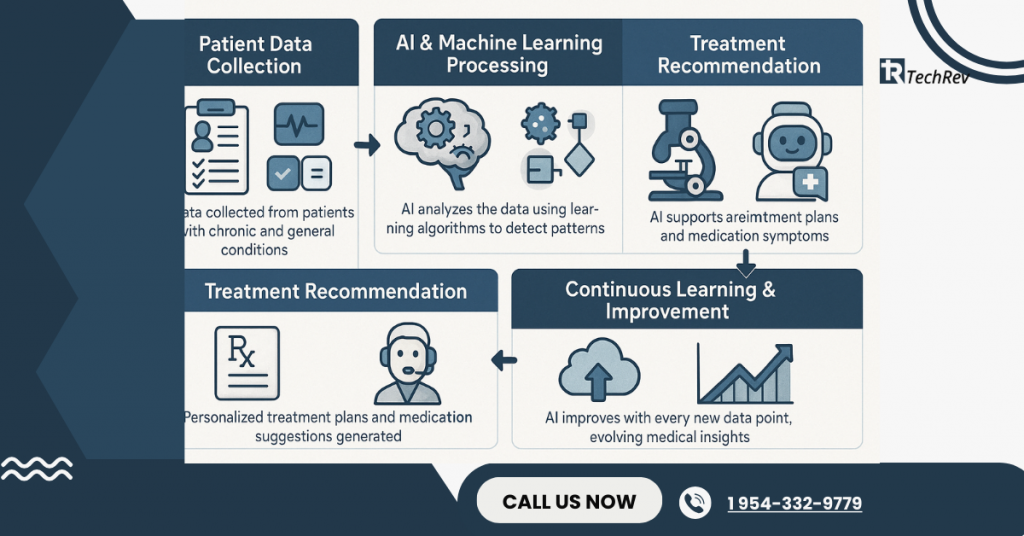In the year 2025, the digital transformation has become quite evident. Every industry is embracing the paradigm shift and taking a leap on technology advancement for their respective businesses. And observing the rising demand for more secure and accessible healthcare apps, the healthcare sector is leveraging it to its optimum extent.
Considering the demand and challenges the healthcare business faces, the blog below provides insight into the latest trends of 2025. And to guide with the information to keep in mind while opting for a tech-driven solution for medical app development, while navigating through queries and challenges to own one.
AI & Machine Learning for Predictive and Personalized Care
The adaptation of technology in medical has led to diagnosis using AI. Furthermore, it has also extended to identifying symptoms and recommending treatment accordingly. The artificial intelligence works on data collected from patients related to medical conditions, and utilizing the algorithm, providers are taking proactive measures. Additionally, solutions or tools are developed to keep track of their behavior related to chronic care management.
Thus, AI is helping with the tracking of health conditions, predicting outcomes for provided treatment, and setting up personalized treatment. With every new or added data, AI is also learning and evolving the medical knowledge and improving its accuracy to assist medical professionals with multiple tasks. It includes creating a plan on comprehensive care and identifying the behavioral pattern for recommendations in terms of treatment, medication, and more.

IoT Integration & Remote Patient Monitoring
The integration of AI in the healthcare sector has also opened up possibilities for remote patient monitoring. Now, healthcare app development is being powered by IoT. It is helping in managing daily wellness and chronic conditions as well. The wearables with integrated IoT track the daily vitals, which are blood pressure, heart rate, glucose, or oxygen level in the blood.
These devices are now integrated with EHR (electronic health record) systems of hospitals. These help in performing tasks of monitoring patients and taking actions by looking at the daily recorded data. Undoubtedly, it is improving hospitals’ and providers’ intervention time and reducing emergency visits and readmissions. Ever since healthcare providers have started utilizing the IoT-integrated remote patient monitoring solutions such as DocVoice, the chronic care management for elderly people has also been improved.
Telehealth Evolution & Virtual Care Expansion
In recent years, there has been an evolution of telehealth in the healthcare sector. Following the telephonic consultation, the platforms are now available to schedule a virtual consultation appointment. The pandemic has led to remote patient monitoring, ultimately expanding virtual care.
Telehealth solutions are being advanced over time, considering the convenience for patients. They now have features like e-prescription, digital triage prioritizing critical data for timely intervention. Therefore, the evolution of telehealth has been quickly adopted by providers as it has helped in rural remote care. As there are many faraway and underserved areas across the USA and the world that are deprived of comprehensive care. The setting up of a virtual ecosystem has made specialized care easy and education for patients effortless.
Voice Technology & Conversational Interfaces
The telehealth and healthcare solution has taken an advanced approach with the integration of voice technology. Many devices come with the assistance of voice reminders. It helps patients and providers both with tracking their health conditions. There would be no miss when it comes to measuring the progress of a person’s wellness after or during treatment by looking at recorded data.
To instantly connect with caregivers, AI chatbots are also establishing uninterrupted and prompt relationships with patients. The flexibility it is offering—from not only getting solutions for their health queries to asking to make instant appointments—the telehealth solution has now come a long way. The AI model is enhancing patient engagement along with offering a seamless and easy-to-understand user experience.
Compliance, Privacy, and Evolving Regulatory Standards
The above features, which are emerging trends of the year 2025 when choosing to find more about medical mobile application development. They are undoubtedly making healthcare accessible, but also raising concerns related to compliance, privacy, and updated regulations.
For the healthcare sector choosing all the above-mentioned emerging trends such as AI chatbots, reminders assistance, remote monitoring, or vital recording—they should have insight on HIPAA, GDPR, or other US regulations. Moreover, if you are expanding healthcare globally, having global knowledge becomes much more important.
Henceforth, it is imperative to choose businesses that are not only equipped with IT solutions to fulfill the requirements but also well-versed in guidelines to deliver custom healthcare app development.
Conclusion: Preparing for the Future of Healthcare Apps
In 2025 and beyond, healthcare providers must embrace digital innovation to stay ahead. By integrating AI, IoT, voice interfaces, and virtual care features while staying compliant with privacy regulations, providers can offer enhanced care and efficiency. Collaborating with tech-driven app and web solution providers ensures healthcare application development for providing a future-ready, smarter, safer, and more patient-centric tool.
Creating an app for healthcare is easy if you reach out to an industry expert. While development, they break down the complete process into the following:
How to develop an app for healthcare
Market and Regulatory Research
Plan Features and Architecture
UI/UX Design
Develop and Test
The cost to develop a healthcare app can range from $30,000 to $500,000+,
Setup Process: To set up a healthcare app, you need to define your features, ensure regulatory compliance, design the UI/UX, build the app, and launch securely
